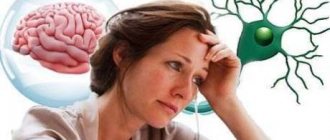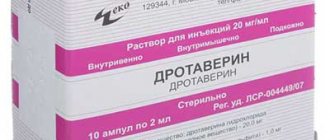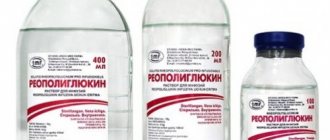Neuromidin is a special drug that is neither a muscle relaxant, nor an analgesic, nor an anti-inflammatory drug. It is not included in any international or domestic protocol for the treatment of acute back pain, and even more so when the pain is caused by discogenic complications of osteochondrosis (protrusions and hernias). The cost of Neuromidin is quite high, exceeding 1000 rubles. Let's figure it out: does using Neuromidin really help with a herniated disc, or is it just a waste of money?
This question is far from idle. Intervertebral protrusions and hernias have all the signs of “convenient” diseases for healers and charlatans. These are the signs:
- there is no immediate threat to life or disability;
- There are many intervertebral discs, and pain is common;
- Acute, discogenic back pain lasts for many years, with alternating exacerbations and remissions, and the patient can be “used” for many years, since the pain goes away anyway, and by using some dubious remedy, you can convince the patient that it helped;
- the severity of the pain is high, and with lumbago the patient cannot turn around and laugh for several days, since the inflamed nerve roots immediately shoot out, and at this time the patient is ready for anything.
Thus, there are many options for conservatively “treating” a hernia: ointments, creams, kinesiotherapy and craniosacral effects, massage and physiotherapy, manual techniques and blockades. One thing to remember: all these treatment methods have nothing to do with a hernia, as with an intervertebral disc defect. They help eliminate the unpleasant symptoms caused by the hernia by “rubbing” the nerve roots, ligaments and muscles.
Without exception, all conservative methods of treatment only help to relieve pain and increase range of motion in the back, but at the same time this is not evidence of a radical cure. This is the result of reduced inflammation, pain and swelling, improved blood supply to surrounding tissues and decreased muscle tone. The hernia will manifest itself again, perhaps it will enlarge, and these methods of conservative treatment will no longer help. Then only surgery will save you.
Pharmacological authorities
Pharmacodynamics.
Neuromidin® is a circulating cholinesterase inhibitor.
Neuromidin® produces a direct stimulating infusion to conduct impulses along nerve fibers, interneuronal and nerve-muscle synapses of the peripheral and central nervous systems.
Pharmacological action of Neuromidin® is based on a combination of two action mechanisms:
- blockade of potassium channels in the membranes of neurons and meat cells;
- reverse inhibition of cholinesterase in synapses.
Neuromidin® exerts its effect on smooth flesh not only on acetylcholine, but also on adrenaline, serotonin, histamine and oxytocin.
Neuromidin® exhibits the following critical pharmacological effects:
- renews and stimulates impulse conduction in the nervous system and nerve-meat transmission;
- will increase the shortness of the smooth organs under the influx of antagonists of acetylcholine, adrenaline, serotonin, histamine and oxytocin receptors, followed by potassium chloride;
- memory fades, the progressive development of dementia is due;
- renews the conduction of impulses in the peripheral nervous system, damaged by the influx of various agents, such as trauma, inflammation, local anesthetics, certain antibiotics, potassium chloride, toxins, etc.;
- mildly stimulates the central nervous system in combination with manifestations of several sedative effects;
- exhibits an analgesic effect;
- exhibits an antiarrhythmic effect.
The drug does not have teratogenic, embryotoxic, mutagenic and carcinogenic effects, as well as allergenic and immunotoxic effects, and also does not affect the endocrine system.
Pharmacokinetics.
Neuromidin® is readily absorbed after subcutaneous or internal lingual administration. The maximum concentration in the blood is reached after 25–30 minutes; 40–50% of the active substance is bound to blood plasma proteins. Neuromidin® quickly reaches the tissues; The period of recovery in the phase is 40 minutes. Metabolized in the liver. The drug is administered either directly or extrarenally (through the scolio-intestinal tract). The drug administration period for parenteral administration is 2–3 years. Excretion is primarily excreted through tubular secretion, and less than 1/3 of the dose is excreted through glomerular filtration. When administered parenterally, 34.8% of the dose of the drug is excreted unchanged.
Mechanism of action of the drug
It is known that the nerves give the order to the muscles to contract, acetylcholine, which is released into the synaptic cleft - the place where the nerve connects with the muscle. Acetylcholine, if not removed in time, will keep the muscle in prolonged contraction. Therefore, “cleaning” the synaptic cleft from acetylcholine is very important, and this is done by the enzyme acetylcholinesterase. So, Neuromidin inhibits it, and acetylcholine circulates longer in the synaptic cleft, and the impulse becomes brighter, longer, more active. It affects the level of potassium channels. As a result, neuromuscular transmission and smooth muscle contractility improve.
Interactions with other medicinal drugs and other types of interactions
Neuromidin® produces a sedative effect when combined with properties that depress the central nervous system. These side effects are enhanced when combined with other cholesterase inhibitors and m-cholinomimetic agents. In patients with myasthenia, there is a risk of developing a “cholinergic” crisis, since Neuromidin® stagnates immediately with cholinergic reactions. There is an increased risk of developing bradycardia, as β-blockers are used before treatment with Neuromidin®.
Neuromidin® can be used in combination with nootropic drugs.
Alcohol enhances the side effects of the drug.
Indications for use: can it be used for hernias?
Therefore, Neuromidin should be used where there is a defect in neuromuscular transmission (for example, muscle weakness and lethargy, when there is a hereditary deficiency of acetylcholine). These are myasthenia gravis and various mysthenic-like syndromes.
The second indication is the actual bad nerves, through which the impulse is carried out poorly, with losses. This is polyneuropathy, for example, in diabetes mellitus, or alcoholic polyneuropathy. In the latter case, many years of alcohol consumption led to the destruction of nerves, and in the first case, high sugar levels. This also includes demyelinating diseases, for example, multiple sclerosis, when the myelin sheath of the nerves is defective, and a “short circuit” and impaired impulse transmission often occur due to poor insulation.
A wide group of indications are various paralysis and paresis, when neurons generate an impulse very poorly, and then it is necessary at the periphery, at the point where the nerve axon approaches the muscle, to somehow strengthen it. These are bulbar paralysis, paresis with motor deficit.
Finally, due to its effect on smooth muscle, Neuromidin is indicated for low intestinal tone and for the treatment of atonic constipation.
Is improved neuromuscular transmission necessary for hernias?
Of course not. Let's remember that:
- the motor neurons that “order” the back muscles to contract lie in the anterior horns of the spinal cord, and are very far from the hernia, which has no effect on them;
- improvement of neuromuscular transmission leads to increased impulse and long action time. With hernias, on the contrary, the muscles are excessively spasmed, and, on the contrary, they need to be weakened, removing the excessive action potential from them.
And finally, the “cherry on the cake”: acetylcholine is a transmitter of the parasympathetic nervous system, and it has nothing to do with the muscles of the trunk or lumbar region. Neuromidin stimulates effects such as:
- slowing heart contractions and dilating blood vessels in the periphery;
- decreased blood pressure;
- increased intestinal motility;
- contraction of the muscles of the gallbladder, bronchi and uterus;
- improved secretion of digestive juice;
- stimulation of the lacrimal and sweat glands, as well as reduction of pupils, due to the effect on the parasympathetic part of the oculomotor nerve.
In addition, acetylcholine is a nerve transmitter within the central nervous system and circulates within the brain. Its deficiency can cause Alzheimer's disease, and therefore Neuromidin can also be used as a drug to help slow the progression of symptoms of this disease.
As you can see, this remedy has nothing to do with herniated intervertebral discs, and cannot have it. Its mechanism of action lies outside the influence on inflammation, pain, swelling and muscle spasm, which occurs with protrusions and hernias.
Features of good stagnation
Care must be taken to treat patients with a history of peptic varicose veins and duodenum, illnesses of the respiratory system, including acute illnesses of the respiratory system, illnesses of the cardiovascular system, etc. suffer from coronary pain and thyrotoxicosis.
Suspension during pregnancy or breastfeeding.
Neuromidin® increases the tone of the uterus and can cause anterior uterine ruptures, so during pregnancy the drug is contraindicated.
The drug is contraindicated during the breastfeeding period.
This is due to the fluidity of the reaction during treatment with vehicles or other mechanisms.
During the treatment period, it is necessary to avoid car bathing, as well as potentially unsafe types of activities that require increased concentration and fluidity of psychomotor reactions.
Modern spinal neurosurgery
Only modern minimally invasive surgical intervention (for example, video endoscopic microdiscectomy, or laser vaporization and nucleoplasty) can remove the hernia defect itself, or prevent its appearance in the case of protrusion. However, the Russian patient knows very well what surgery is. It hurts. This takes you out of normal life for a long time. It may be dangerous. There are so many such “buts” that surgery is considered the last type of treatment, when massage therapists, carboxytherapy sessions, manual therapists and kinesiotherapists stop helping.
Fortunately, in European countries, Israel, and the USA, the approach is completely different. If there are indications, the patient is operated on without pain, and often leaves the hospital on his own feet on the same day or the next. His quality of life is preserved. He is not prohibited from sitting for many days, and he is not forced to relieve himself while standing. Therefore, modern surgery is considered the best, fastest and most effective means of radical treatment. By the way, doctors in many Eastern European countries, for example, the Czech Republic, show excellent results in treating hernias surgically at fairly modest costs.
In Russia, they prefer not to immediately remove the hernial protrusion, but for many years to deal with its consequences and complications - to periodically treat inflammation, pain and swelling of the roots, which persistently arise again and again. And in this respect, the domestic patient resembles an unfortunate driver who, instead of finally changing a punctured tire, is forced to pump it up every half hour of driving. Only, unlike the driver, a patient who has been “treating” a hernia for a long time sometimes spends several times more money than the operation would cost.
Cervical hernia on MRI.
But even among the drugs for relieving swelling, back pain, and excess muscle tension, Neuromidin is not “listed.” However, it is sometimes prescribed for hernias, and is completely unjustified. The situation is aggravated by an unimaginably large number of sites that are written with stunning medical illiteracy. Because if there is a request “How to take Neuromidin for hernias,” then a helpful but illiterate article will immediately appear, which can even harm your health. How to take Neuromidin for hernias? Don't accept it at all. But first things first….
Method of congestion and dosage
Injections for injection should be administered internally or subcutaneously. The dose and severity of treatment should be determined individually depending on the severity of illness.
Diseases of the peripheral nervous system:
Mono- and polyneuropathies of various origins: administered subcutaneously or internally 5–15 mg 1–2 times per dose, treatment course 10–15 days (in severe cases up to 30 days); Give the liquid a trace and chew the tablet form of the drug.
Myasthenia and myasthenic syndrome: administered subcutaneously or internally 5-30 mg 1-3 times per dose, with further transition to the tablet form. The final course of treatment lasts 1–2 months. If necessary, treatment can be repeated several times with a break between courses of 1–2 months.
Diseases of the central nervous system:
Bulbar palsy and paresis: subcutaneously and internally 5–15 mg 1–2 times per dose, treatment course – 10–15 days, switch to tablet form if possible.
The current period for organic disorders of the central nervous system:
internally 10–15 mg 1–2 times per dose, course of treatment for up to 15 days, further as possible 1-2 times per dose.
Interactions with other medications
Neuromidin may also interact with other medications. It enhances its sedative effect if used with drugs that depress the central nervous system, such as sleeping pills, tranquilizers from the benzodiazepine group, or together with barbiturates. Let us recall that a well-known representative of barbiturates, phenobarbital, is included in Valocordin and Corvalol, which are sold without a prescription. If you combine Neuromidin with beta-blockers, which reduce the heart rate and heart function, there is a risk of bradycardia, collapse and fainting.
Overdose
Symptoms
In case of severe overdose, a “cholinergic crisis” may develop, which is characterized by:
bronchospasm, lacrimation, increased sweating, ringing, nystagmus, increased perilstatics of the scolio-intestinal tract, spontaneous defecation and vomiting, vomiting, chewing, bradycardia, disruption of the intracardiac system fluidity, arrhythmias, decreased arterial pressure, turbulence, anxiety, arousal, fear, ataxia , seizures, coma, impaired speech, drowsiness, mental weakness.
Likuvannya:
Follow with symptomatic therapy and use m-cholinergic blockers: atropine, cyclodol, metacin, etc.
Contraindications
Injections with Neuromidin are prohibited from use if a person has one of the following conditions:
- Extrapyramidal diseases accompanied by hyperkinesis.
- Angina pectoris.
- Epilepsy.
- Bronchial asthma.
- Pregnancy or lactation period.
- Aggravated ulcer of the duodenum or stomach.
- Vestibular disorders.
- Severe bradycardia.
- Mechanical obstruction of the urinary tract and intestines.
- Excessive sensitivity experienced in relation to the active substance of the drug or to the auxiliary substances.
- Too young (under 18 years old). The drug is not prescribed to children, since there is no systematic data that could confirm the effectiveness of its use.
But that’s not all you need to know about the instructions for using injections with Neuromidin. There are conditions in which they are prescribed with caution. Namely:
- Diseases of the cardiovascular system.
- Ulcer of the duodenum and stomach.
- Thyrotoxicosis.
- Acute or obstructive diseases of the respiratory system.
In any case, after a careful examination and study of the patient’s medical history, the doctor will tell whether the drug will help his patient or not.
By the way, during treatment you will have to give up driving, as well as potentially dangerous activities, because sometimes the drug impairs the ability to concentrate.
Side effects
Neuromidin®, like other medications, may cause adverse reactions, although the effects do not appear in all patients.
Frequency of adverse reactions according to MedDRA (Medical Dictionary of Regulatory Activities) classification:
very often (≥1/10); often (≥ 1/100 to < 1/10); uncommon (≥ 1/1000 to < 1/100); rare (≥ 1/10,000 to < 1/1000) even rare (< 1/10,000); frequency is unknown (impossible to calculate based on available data).
Damage to the side of the heart
: often – increased heart rate, bradycardia.
Damage to the side of the nervous system
: infrequently - confusion, headache, drowsiness (when taking high doses).
Damage to the sides of the respiratory tract, organs of the chest and the mediastinum
: infrequently - reinforced by bronchial secretion, bronchospasm.
Damage to the side of the scolio-intestinal tract
: often – increased sleepiness, tediousness; infrequently - with high doses - vomiting, rarely - diarrhea, pain in the epigastric region.
Damage to the side of the stove
: frequency of the unknown – zhovtyanitsa.
Damage to the sides of the skin and underside fabrics
: often – increased sweating; infrequently allergic reactions, including hissing, itching, kropivyanka, angioedema.
Damage to the side of the reproductive system
: improvement of uterine tone.
Damage to the side of the fistula-meat and tissue
: infrequently - meat courts (with high doses).
Damage to the side of the immune system
: frequency of unknown - hypersensitivity reactions (including allergic dermatitis, anaphylactic shock, asthma, toxic epidermal necrolysis, erythema, urticaria, whistling, laryngeal swelling, visip on the place of in'ektsiya).
Substance disturbances and reactions at the site of administration:
infrequently – weakness (with high doses).
Anticholinergic agents, such as atropine, may reduce sleep apnea and bradycardia. If undesirable side effects occur, change the dose or briefly (for 1–2 days) interrupt the drug administration u.
Impact on the body
You can learn about it if you read the instructions for using injections with Neuromidin. The main active ingredient directly affects the conduction of impulses along nerve fibers, interneuronal and also neuromuscular synapses of the central nervous system and PNS.
After using the drug, potassium channels of muscle cells and neuronal membranes are blocked, and reversible inhibition of cholinesterase begins.
Even after injections with Neuromidin, the effect of oxytocin, histamine, serotonin, adrenaline and acetylcholine on smooth muscles increases. In addition, we can highlight a whole list of pharmacological effects that appear as a result of treatment:
- The conduction of impulses in neuromuscular transmission into the nervous system is improved and stimulated.
- Improves memory and ability to concentrate.
- Due to the effects of oxytocin, histamine, serotonin, adrenaline and acetylcholine receptor agonists, smooth muscle contractility increases.
- The progressive development of dementia is inhibited.
Reviews
Finally, a few words about what people who have been treated with it, as well as doctors, say about this drug.
Judging by the comments of doctors, Neuromidin has proven itself well in many medical fields. It perfectly improves neuromuscular conduction, and therefore is effectively used in the treatment of all previously listed diseases.
What do patients say? To begin with, it should be noted that this drug is not prescribed to all people - only to those who have encountered the above diseases. In some, a nerve (or several) is so severely damaged that it becomes impossible to control the limb to which it is connected or to control the reactions of the place to which it is connected.
However, most patients note one thing - their condition slowly but surely begins to improve. Some people whose leg (for example) was “in failure” say that after completing the course they regained the ability to move it.
Following this, the affected area begins to strengthen, and movements become more confident. Sensitivity and the ability to sense touch also returns. Of course, all this is not only thanks to the drug, but also due to an integrated approach to treating the disease.
But nevertheless, with the help of Neuromidin, many patients were able to restore sensitivity, the health of the affected nerve and the function of the damaged area. Most people have regained the ability to enjoy their mobility and life. And this is the best confirmation of the effectiveness of the drug.
Overdose
In case of an overdose, not only side symptoms may occur, but also various complications. If the fact of an overdose of a medication is relevant, then this condition will be accompanied by a decrease in appetite, increased salivation, accelerated intestinal motility, as well as the appearance of diarrhea and excessive urination.
A significant overdose of the drug can lead to damage to the heart muscle, as well as arrhythmia, seizures, loss of coordination and consciousness. A person may fall into a coma, so it is very important to follow the dosage and regimen of the medication.
It is important to know! To eliminate signs of overdose, they resort to the use of symptomatic drugs, presented in the form of Atropine or Metacin.
Analogs
They are also worth listing. Many people are interested in finding Neuromidin analogues cheaper! Some people consider injections of the original drug to be expensive.
Well, alternative medicines cannot be called budgetary either. The active substance itself is expensive, and therefore it will be difficult to find a cheap analogue. But, if you have to select a replacement, you can pay attention to the following means:
- "Ipigrix."
- Amiridine tablets.
- "Axamon."
- "Amiridine" 20 mg.
- "Ipidacrine."
These are complete analogues in substance. There are also drugs similar in action to Neuromidin. These include “Reminil”, “Nivalin”, “Galantamine”, “Prozerin”, “Thiamin chloride”, “Pyridostigmine bromide”, “Thiamin”.
But be that as it may, even if for some reason a person has to select an analogue, only his attending physician can do this.







